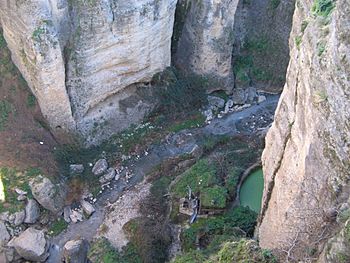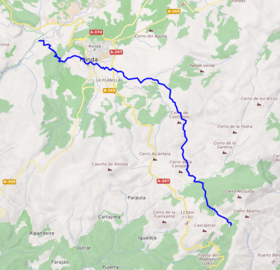Guadalevín facts for kids
Quick facts for kids Guadalevín |
|
|---|---|

View of the Guadalevín from one of the bridges at Ronda.
|
|

Course of the Guadalevín
|
|
| Native name | Río Guadalevín (Spanish) |
| Country | Spain |
| Region | Andalucía |
| Basin features | |
| River system | Guadiaro |
The Guadalevín is a short but important river in southern Spain. It flows through the beautiful region of Andalucía, specifically in the western part of Málaga province. This river is a branch, or tributary, of the larger Guadiaro River.
The Guadalevín is famous for carving a deep gorge that splits the city of Ronda. Three historic bridges cross this gorge: the Puente Nuevo (New Bridge), Puente Viejo (Old Bridge), and Puente Romano (Roman Bridge). The name "Guadalevín" comes from an old Arabic phrase, “Wadi-al-Laban,” which means "river of milk."
Contents
River's Journey
The Guadalevín River starts its journey in the Sierra de las Nieves Natural Park. This area is known for its unique Spanish fir trees. As the river flows, it is joined by the Fuenfría stream. It also gets water from the Oreganal mountain range, including the Malillo spring. After these additions, it is sometimes called the Rio Grande, meaning "Big River."
Later, the river reaches the city of Ronda. Here, it has carved out the famous Tajo Gorge, a stunning natural canyon. The river then flows onto the Ronda plateau, still known as the Guadalevín. In an area called La Indiana, it meets the Guadalcobacín River. The Guadalcobacín itself is fed by streams like the Ventilla, which flows through a rocky gorge near Arriate.
Where the Guadalevín and Guadalcobacín rivers meet, many people consider this the beginning of the Guadiaro River. However, some experts believe the Guadiaro officially starts a few kilometers downstream. This is when the Guadares River, which comes from the Cueva del Gato (Cat's Cave), joins the main flow. The area around the Guadalevín River is made up of different types of rock, including gypsum, sandstone, and limestone.
Plants and Trees
The plants and trees along the Guadalevín River are typical of the Mediterranean climate. You can find many species that are adapted to the warm, dry summers and mild, wet winters. These plants thrive in the specific soil and climate conditions of the Ronda region.
Animals and Wildlife
The Guadalevín River is home to many interesting animals, especially those that live near water.
Water Animals
- Otters: These playful mammals are often seen swimming and hunting in the river.
- Turtles: The leper turtle is one of the species found here.
- Fish: You might spot fish like the marine lamprey, tusk, gypsy barbel, Málaga chub, and eel.
- Invertebrates: Look for crayfish and different types of dragonflies (odonates). The black cork oak spider, which is unique to southern Spain, also lives here.
Amphibians and Birds
- Amphibians: The southern pintopod sapillo (a type of toad) and a subspecies of salamander live in the river's moist areas.
- Birds: Common birds include the blackbird and the colorful kingfisher. Various species of birds of prey, like eagles or falcons, can also be seen flying overhead.
See also
 In Spanish: Guadalevín para niños
In Spanish: Guadalevín para niños
- List of rivers of Spain
- Puente Nuevo (Ronda)
- Puente Viejo (Ronda)

